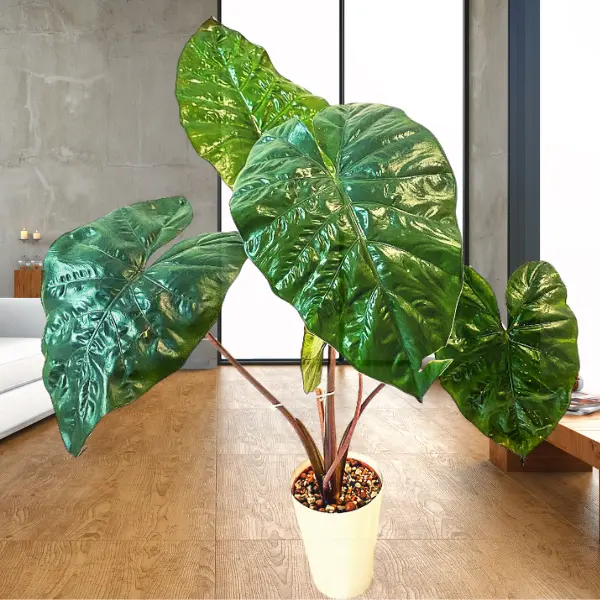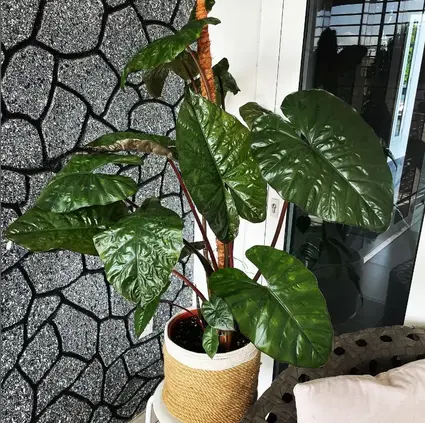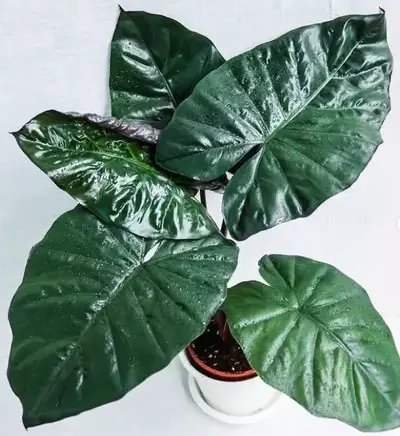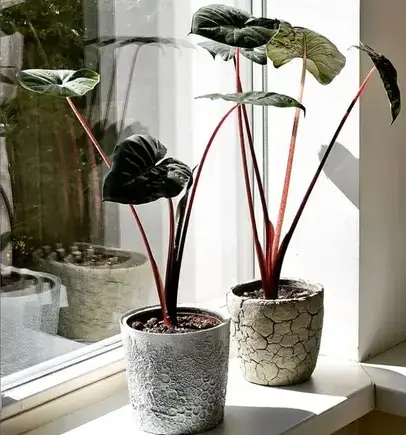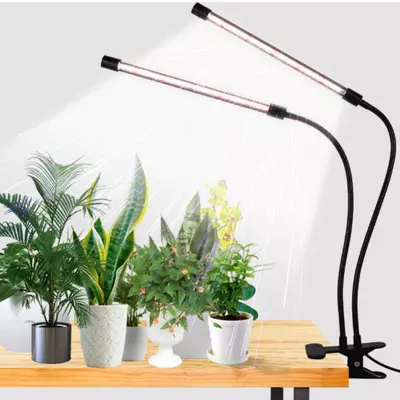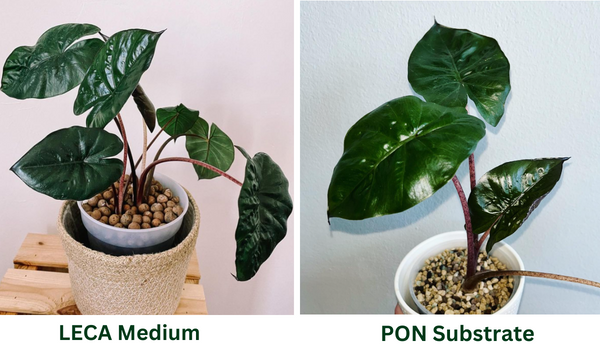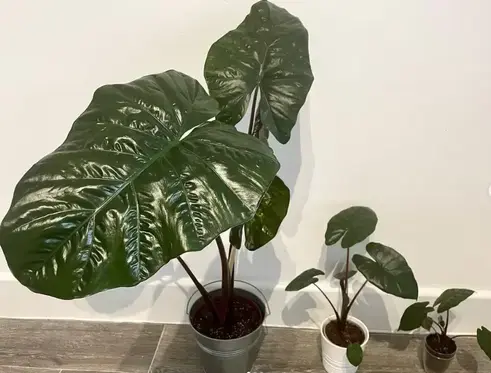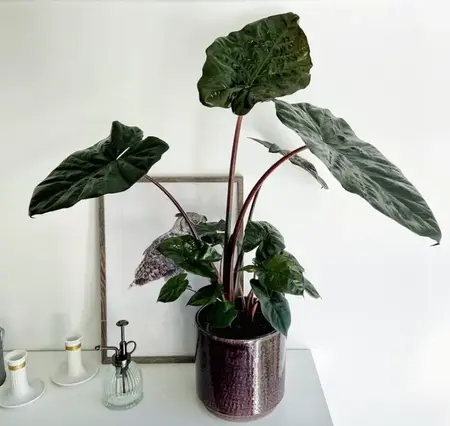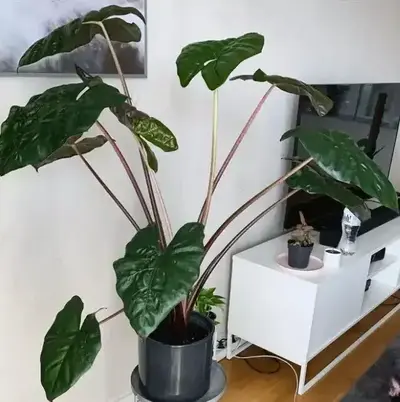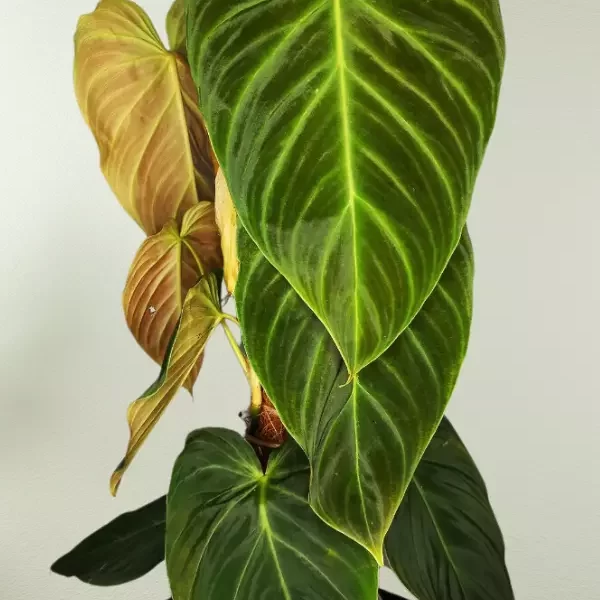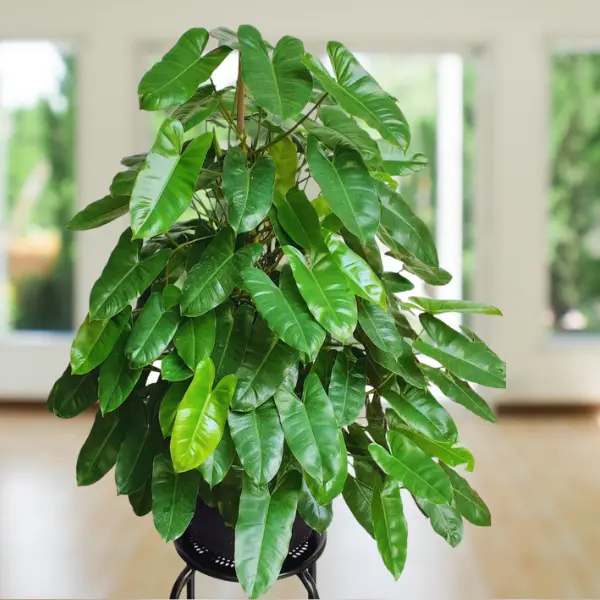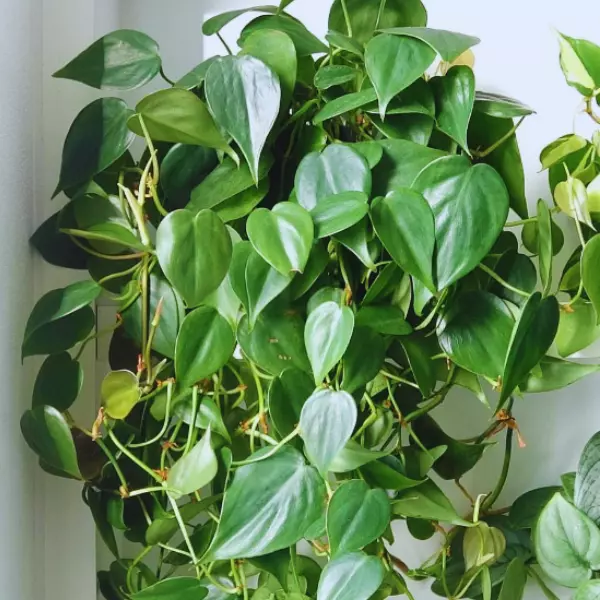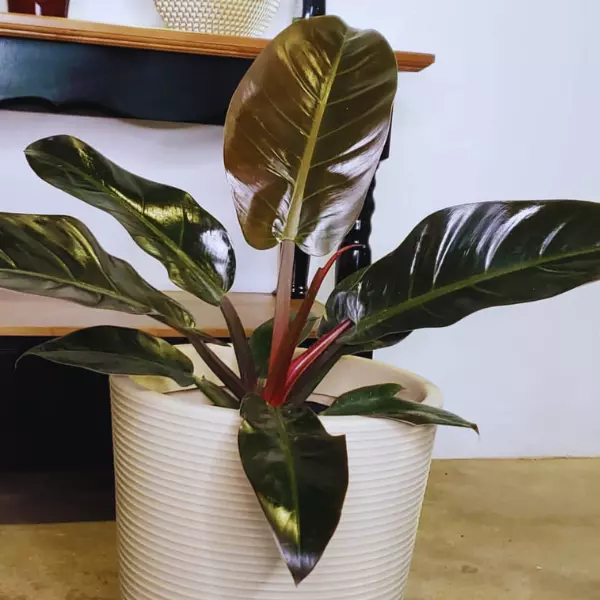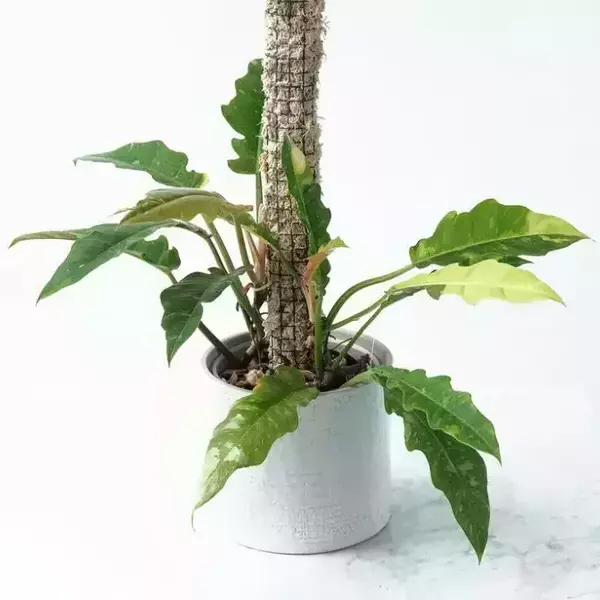Dear Gardeners!!
If you want to add a dramatic look to your home, there is no plant better than exotic and bold Alocasia Yucatan princess. This beautiful plant flaunts large dark green crinkled glossy leaves with brown underside and velvety red stalks. The Alocasia Yucatan princess is also known as Elephant Ear due to its large leather like leaves. It’s typically grown for its attractive foliage that makes it an exceptional decorative plant. The leaves of ‘Yucatan Princess’ may come in two colors; dark, almost black-leaved form of Sarawakensis featuring enormous, glossy, puckered top side of the leaves and maroon undersides attached to maroon stems or petioles. In contrast, the other variant of Yucatan Princess exhibits large, lustrous dark green leaves with dark brown undersides and prominent brown venation.
Allied Species: Alocasia Macrorrhiza Variegata, Alocasia Ivory Coast, Alocasia Sarian, Alocasia Pink Dragon, Alocasia Lauterbachiana, Alocasia Stingray, Alocasia Regal Shields, Alocasia Jacklyn, Alocasia Macrorrhiza, Alocasia Sanderiana
Related Products
Products | Name | Check Price |
Organic Perlite for Plants | ||
WONDER SOIL Organic | ||
Orchid Potting Bark Mulch |
Habitat & Ecology
This aroid is native to the island of Borneo, a natural mutation of Alocasia Sarawakensis. This plant is in the Araceae family, in the Arum classification. This plant naturally grows along coastal stretches of northern Borneo, hence the name Sarawakensis, derived from Sarawak, a state in Malaysia. Although it also naturally occurs in Sabah, located on the northern point of the island of Borneo in Malaysia, it also lives in Brunei, parts of Kalimantan and even parts of Sumatra in Indonesia.
| Botanical Name | Alocasia Sarawakensis Yucatan Princess |
| Family Name | Araceae |
| Common names | Alocasia Yucatan Princess, Elephant ear |
| Species | Sarawakensis |
| Origin | Borneo |
| Height | 6–8 feet |
| Temperature | 65F-72F |
| Humidity | 50% and above |
| Light Need | Bright indirect sunlight |
| Soil Type | Well-draining, moist |
| Flower Inflorescence | creamy white |
| Hardiness Zone | 9-11 |
| Propagation | Basal Offset Division |
| Pest and diseases | Spider mites and root rot |
Growth
The Alocasia Yucatan princess is a fast growing plant if the conditions are right and its needs are fulfilled. This striking beauty can grow up to 4 to 8 feet high and 4 to 5 feet wide if provided with the proper care. Single plant can grow maximum four to six leaves at a time. Also, you can expect the glossy dark green leaves held high on red sturdy stem to grow to a substantial size making a salient statement at any space it’s placed.
This plant has sagittate to Chordate leaves (arrow-shaped to spade-shaped) with prominent veins and a glossy finish. Leaves are sturdy and somewhat succulent. Yucatan princess has an exciting growth habit of all the leaves originating from a central point sitting on succulent petioles, with the cataphyll developing from the petiole of the most recent leaf. This plant grows a lot like a Colocasia. It has a spadix inflorescence that usually comes in shades of yellow and cream.
Plant growth is active during Spring and Summer but it goes to dormancy during winter. Hence, plant experts advise lessening the watering frequency in winter and also halting fertilizing the plant as there is no growth in that season.
When a new leaf emerges, most of the time, the oldest leaf will die back yellow and fall off, which is normal. This plant has a dormant period, usually around October in the Northern Hemisphere; losing one to all leaves is normal so long as the bulb stays firm and healthy.
How do you take care of Alocasia Yucatan Princess?
It’s an easy Alocasia to grow and happily thrive if it gets the correct attention and care. This plant favors warm bright light and is fond of high humidity. Also, the plant prefers moist soil with a short drying out period between watering. If you want to keep this plant happy indoors then provide it warm environment.
In this article, we will cover every aspect of Alocasia Yucatan princess care and growth tips. Keep reading below to learn how to keep this beautiful houseplant happy and thriving.

Initial Care at Home
Alocasia Yucatan Princess plant needs proper care and attention to flourish when grown indoors as house plant. Therefore, make sure you provide an environment similar to its natural habitat for its growth and nourishment.
When you bring the Alocasia Yucatan Princess home, it may shed a leaf or two initially to acclimate to new environment. This dropping of leaf is normal as plant may stress out in the beginning.
Place your Alocasia in a bright space where it gets indirect sunlight. Check the soil and ensure that it’s well-draining and aerated. Don’t rush in repotting your Yucatan Princess as it may stress the plant. Let the plant acclimate for a month or two.
We suggest quarantining your new plant it from other plants at home. The reason for isolation is to inspect for any pests or diseases, and it shouldn’t spread among other plants in your collection.
The best practice is to shower your new plant to remove any pests or dirt.

How often should I water my Yucatan Princess?
This beautiful houseplant prefers a constant moist soil but it shouldn’t be soaked. It also likes brief drying period before watering, therefore, water it only when the upper layer of the soil is dry. Being said that, in summer the watering frequency increases as plant needs more water due to recurrent soil drying of warm temperatures while it’s the opposite in winter.
However, you should be careful with watering as this elusive plant is highly susceptible to overwatering that can result in serious fungal infections and root rot, while it also doesn’t like underwatering because it can result in stunted growth. Therefore, determine the watering needs of the plant wisely.
You can adopt few methods that can help you to detect if plant needs water. The preferred technique is to insert finger in the soil and if it feels dry till the knuckle, means your plant is thirsty. Another practice is checking the weight of the pot, if its feels lighter, your beloved green baby desires water. Use distilled and lukewarm water to keep your plant thriving and preventing from shock.
Bottom Watering
An effective way of hydrating your plant without risking overwatering is bottom watering the plant. It helps you to avoid drowning your plants in their pots. This way, the potting mix only absorbs as much moisture as it needs rather than forcing your plant by top watering it. It also prevents certain pest infestations, as the top layer of soil will stay dry when bottom watering your plant.
Fill a bowl or water tub with room-temperature water, place the plant pot in the water container and let it sit for 15 minutes or so. The potting mix will soak the water it needs through the pot’s drainage holes. Please don’t let the plant sit for hours in the water container to avoid soaked soil.
When you notice the signs of overwatering such as yellowing of leaves and soil molds, reduce the frequency. It is always a good practice to use a moisture meter or moisture sensor to monitor the soil dryness.

Light Requirements
Like all other Alocasias, the Yucatan princess also likes bright and indirect light. Therefore, place it in a brightly lit location where it can receive enough light but don’t expose it to direct sun as it can damage its lush green leaves.
Although, this plant can bear morning light for few hours but extended period of direct light especially afternoon sun can scorch its leaves, however, the Yucatan Princess also doesn’t light lowlight conditions as it can result in stunted growth.
Lack of light cause a leggy plant with extended petioles and smaller leaves. However, you can always supplement your plant with grow lights to provide the required light for healthy growing.
The plant is best suited for bright indoors spots near windows but if you want to keep it outdoors, make sure to provide a partial shade and keep it away from the harsh afternoon sun, especially during summers. Too much sun exposure can cause serious damage to its leaves and change their colour.

Humidity and Temperature
The Alocasia Yucatan princess likes to stay in high humid conditions and shows rapid and healthy growth in 50% or more humidity levels. The best place for this plant at home is kitchen and bathroom where the humidity is high. If the required humid levels drop, try misting your plant to increase the humidity in the plant’s surrounding. Moreover, following methods are also effective to elevate humidity;
- Set up a humidifier near the plant.
- Grouping it with other plants is also a good option.
- Place a pebble tray near the plant container.
Correspondingly, the Southeast Asian origin makes the Yucatan Princess plant enjoy warm weather conditions. at a temperature ranging between 65 to 72 degrees Fahrenheit.
Yucatan Princess plant is highly intolerant to cold conditions and cannot survive in chilly environment, hence, don’t keep it outside in winter. Also, keep it away from air conditioners heaters and near frosty windows in cold weather. It also sensitive to sudden temperature changes because it affects its growth significantly.

Soil Requirements:
Yucatan Princess proliferates in loose, nutrient-rich, and well-drained potting mix. Plant Yucatan Princess in soil that can retain moisture and drain out excess water to avoid root rot and many other diseases. Also, the soil should have chunky components so the plant’s roots don’t sit in dense, water-logged soil.
The growth and health of your plant is highly dependent on the growing substrate. We suggest using a potting mix with variable-sized components to create air pockets to provide aeration and drainage in the soil. You can prepare a potting mix for your Yucatan Princess by mixing the following ingredients.
- 25% Potting soil
- 25% Peat moss or Coco Coir: For water and nutrient retention.
- 20% Perlite: Improves aeration, draining and insulation
- 20% Orchid bark: To make soil chunky to provide aeration and drainage.
- 10% Horticultural Charcoal: To balance the pH of the soil.
Please never use regular garden soil for your Alocasia Yucatan Princess, as that soil is dense and retains too much water, which may suffocate the roots leading to root rot.
Besides that, if you don\t want the hassle, you can also choose from our recommended potting mixes available in the market, such as:
Growing in Semi Hydroponics
Alternatively, Alocasia Yucatan Princess seems to enjoy in LECA clay balls and PON especially when younger.
To transplant your plant into PON, remove the soil from the root ball by gently tapping and then rinsing the roots with water. Later fill a glass jar or self-watering planter with PON and placing the root ball in the PON jar. We recommend using a self-watering planter for PON as it reduces the risk of overwatering which can lead to root rot.

Repotting
Alocasia Yucatan likes to stay root bound but it needs repotting after one or two years. Repotting encourages the plant’s growth if it’s done properly. The prominent signs of root bound is when the roots coming out from drainage holes. The best for this process is active growth season as the plant can easily adjusts to new place.
Step-by-step guide for repotting:

Propagating Alocasia Sarawakensis Yucatan Princess
Like other Alocasias Sarawakensis Yucatan Princess can be propagated in various ways but the most successful techniques are corm Propagation and offset division. The best time to propagate your plant is Spring and Summer when the plant is actively growing.
Propagation through Corms
Alocasias Yucatan Princess plants develop corms in their roots that can be planted in separate pots to produce new Alocasia plants. To collect these corms you might need to dig around the potting soil of your Alocasia plant and inspect the roots and soil to find the corms. Gently pluck the corms from the roots.

You can root these corms in various growing mediums such as water, leca, sphagnum moss or potting mic. We suggest rooting corms using shallow puddle method or sphagnum moss container for successful rooting. To speed up the rooting, placing the corm containers on heating mats also helps.
For shallow puddle method, place the corms into the dish filled with a little water ensuring the corms are not submerged completely. You can cover the dish with a lid or plastic wrap for a couple of weeks. Once the corms root you can plant those in potting mix in separate containers to grow as independent plants.
Pro Tip: You will be most successful in finding the corms during repotting.
Offset Division
Like all Alocasias, Yucatan Princess can reproduce asexually, growing genetically identical “pups” connected to the parent plant by a stolon (like an umbilical cord). Healthy plants continue to grow pups as they mature, making the plant bushier to fill the pot.
However, these basal offsets can be separated from the mother plant and can be planted in separate containers to start as new independent plants.

Fertilizer
This Alocasia Yucatan Princess needs fertilizer to boost its growth and progress as the fertilizers contain extra nutrients that are beneficial to its foliage growth. It’s a healthy practice to feed the plant once a month in growing season that is spring and summer while it doesn’t need feeding in winter as its growth slows down in colder months.
A slow-release granular fertilizer or any liquid balanced fertilizer rich in Nitrogen is perfect for Alocasias to provide nutrients to boos the foliage growth. Moreover, you can also feed your plant an organic fertilizer such as fish emulsion, worm castings or liquid dirt.
However, make sure the doesn’t get over fertilized as extra feed may burn the plant roots while under feeding may result in slow growth.
The best season for composting is spring and summer, and try not to fertilize the plant in the winter months as the plant’s growth stops during this time, and it doesn’t need any additional nutrients.

Maintenance and Pruning
As the Yucatan princess is a fast growing plant, it needs pruning regularly. It’s easy to grow but needs consistent care to maintain its growth and health. This exotic plant possesses gigantic leaves that grow pretty big and to sustain the shape, prune off old and damaged leaves.
As the Alocasia Yucatan Princess grows, the old leaves fall off to make space for new ones. When you spot old and yellow leaves on the plant, clip them as they look unpleasant and make the plant unattractive.
It’s also recommended to use disinfected pruning shears and gloves when dealing with this plant. More over you can always propagate that cut stem in water and later plant in a separate pot.
Pruning is also effective when pests and other diseases attack the plant to remove the infected parts to prevent the spread.

Toxicity
Alocasia Yucatan princess plant is highly toxic to humans and pets as it contains high severity poisonous characteristics. Always keep the plant away from children and pets to avoid direct contact and ingestion.
In case of consumption, it cause irritation to skin, swelling in mouth, eyes, vomiting and nausea. In addition, it can also lead to more severe symptoms such as diarrhea, and drooling. Your eyes may also have pain, redness and swelling.
And if the plant is accidentally consumed, immediately wipe out the mouth with a wet cloth and drink milk. Also, quickly contact the doctor. If your pet munches the plant, instantly rush to the vet.

Pests, Diseases & Common Problems
Alocasia Yucatan princess is a delicate plant and is prone to spider mites attack. Don’t let your plant to stay in dry conditions for prolonged period as it can cause spider mite infestation. If you notice tiny yellowish blotches and spots on leaves, leaf edge scorching and if leaves falling off prematurely, it’s an indication of spider mite invasion.
To treat the issue, use an alcohol and water solution by diluting one cup alcohol and 30 oz water and spray the plant leaves with this mixture and wipe off with paper towel later on.
You can also use neem oil solution to treat this issue as neem has disinfectant and antibacterial properties.
Diseases
The Alocasia Yucatan princess is also vulnerable to many diseases and most common one is the root rot. It’s a serious and dangerous condition that can even kill your plant.
The major cause of root rot is overwatering dense potting mix and poor drainage of the pot,. When you water the plant beyond its needs without letting top inches of the soil dry out, its roots start to rot.
Root rot is a serious condition which can cause the plant’s death. The symptoms of this diseases are yellow leaves, black spots on the stems and black roots that feel mushy. The affected roots can fall off easily when touched.
If you notice these signs in your Yucatan Princess plant, uproot the plant from the pot and check the roots thoroughly. Also trim off the damaged foliage and plant the Yucatan princess in a new pot with fresh potting soil.
Common Problems
This Alocasia plant also bump into some issues that are
Overwatering: The most significant and serious problem with Alocasia plants is overwatering. When you overwater this plant, it can develop some serious issues including root rot. Therefore, always keep an eye on the watering frequency of yur plant and give it a drink, only when it needs.
Underwatering: This is also a serious condition which can result in dry and crispy leaves. The dryness can cause stunted growth. Always look for the water needs and don’t leave your plant thirsty.
Scorching: If your plant is placed in an area where it’s exposed to elongated hours of direct sunlight, it can likely to burn its foliage. The leaf burn is reversible, therefore, keep your plant in a space where it doesn’t get direct sunlight.
Leaf Curling: If the plant doesn’t receive sufficient humidity, its leaves will start drooping along with other symptoms of low humidity, such as leaf curling and brown edges and tips of the leaves. If you notice these symptoms, look for the humidity levels.

Frequently Asked Questions:
Q. How do you plant a Yucatan Princess?
For your plant to thrive, keep it in a spot where it receives bright indirect light, the soil should be moist and well-draining and humidity should be high.
Q. Do Alocasias need lots of light?
No, your Alocasia doesn’t need lots of light. Its needs moderately lit space with indirect sun and can also bear some hours of direct light especially the morning sun but it’s no fond of direct sun for long time.
Q. Can Alocasia get morning sun?
The outdoor Alocasias do great in partial shade and morning sun for some hours but few varieties that have large, dark and thick leaves can tolerate full sun when tempered.
Q. Is Alocasia Yucatan Princess a rare plant?
Alocasia Yucatan Princess is adored by many plant lovers but is not rare as it is being cultivated widely. Alocasia Yucatan Princess is easy to maintain and grow that will certainly be a good addition to your plant collection.

Final Words
The Alocasia Yucatan Princess is a striking decorative houseplant featuring large glossy dark green leaves with prominent veins and red stalk. This plant can lit any space with its lovely looks and presence.
It’s an easy to care plant and doesn’t pretty well in a tropical like environment where it can receive everything it needs for the growth. To keep this beauty happy and thriving, offer it proper care and attention.
It’s a must have plant for the plant lovers because of its easy to go nature and stunning gazes.
If you provide the best care to the plant, you can enjoy its presence for years.
Related Posts
Philodendron Melanochrysum Care & Growing Guide
The Philodendron Melanochrysum, a majestic symphony of nature, also known as the ‘Black Gold Philodendron,’ the botanical gem is a captivating pageantry of lush hues and rich textures, emanating a unique blend of elegance and resilience from the tropical heartlands…
Philodendron Burle Marx Care & Propagation Guide
Philodendron Burle Marx holds a unique and distinguished position in the world of houseplants. The most notable feature of the Philodendron Burle Marx is its large, glossy leaves, which come in heart-shaped or arrow-shaped variations. These leaves are adorned with…
Philodendron Scandens-“Sweetheart Plant” Easy Care Tips
Philodendron Scandens, often called the “Heartleaf Philodendron” or the “Sweetheart Plant” earns its evocative namesake through its captivating physical attributes. This perennial vine exhibits heart-shaped leaves that dangle delicately from slender and wiry stems. These leaves, adorned in glossy shades…
Philodendron Erubescens ‘Imperial Red’ Care Tips
The Philodendron Imperial Red, a botanical marvel, epitomizes the perfect fusion of elegance and vibrancy. Botanically known as Philodendron Erubescens, this plant traces its origins to South America’s lush and verdant tropical rainforests. Its exquisite appearance is characterized by lush…
Philodendron Ring of Fire Care & Growing Tips
Unleashing a maelstrom of botanical charm, the Philodendron Ring of Fire stands resplendently as a masterpiece of nature’s artistry, weaving together the vibrancy of hues and the allure of unusual form in an intimate dance of unparalleled allure. Philodendron Ring…

